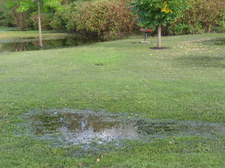
Welcome to the Hessenauer Sprinkler Repair and Irrigation blog and website. We like to offer our online readers some tips concerning sprinkler irrigation. Today we would like to give some advice about how to troubleshoot pipe leaks involved with your irrigation system by finding the leak and resolving the problem.
Pressure loss, geysers, dry spots and overly saturated areas are but a few of the problems associated with broken sprinkler lines. So cast off the yoke of overpriced landscapers, gather together courage and shovel, and fix it yourself. Your wallet will be glad you did.
If your sprinkler heads have stopped functioning and you notice new, soggy patches of grass or soil along your sprinkler lines, you most likely have a leak. Generally, we suggest calling a professional to handle these situations but sometimes, certain issues can be handled by the homeowner.
A broken sprinkler pipe can be a major headache, and many irrigation companies can't be bothered to service a system that they didn't install. The repair bill can run hundreds of dollars or more, and in the meantime, your irrigation system is offline and your lawn is Sprinkler Installation turning brown. The truth is that fixing a sprinkler pipe is simple, once you've located the leak.
The first item of business is to figure out where your pipe is leaking. You might be able to tell simply by seeing where soggy patches have been appearing on your lawn. If some of your sprinkler heads seem to have low pressure but you can't tell where the problem is, place caps on all your heads to restrict water flow and turn on all sprinkler zones. Then, wait to see where water emerges through the soil.
It can take many hours to find a leak in your irrigation system, which is why repairs can be so expensive. If you know you have a leak, you should know which sprinkler zone is the problem. Turn that zone on manually at the control box. If you see a reduction in water pressure between two sprinkler heads in the leaky zone, the leak is somewhere between them. If some of the sprinkler heads don't come on at all, note the sprinkler that is farthest from the valve box, and identify the sprinkler head closest to it that isn't coming on. The leak is between these two. Now leave the zone running. Over time, the ground over the broken pipe will start to seep water.
Once you find the location above the leak, dig down to the leak, being careful not to cause any more damage to the pipes. Before you dig, shut off the sprinkler controller so no water can flow through the pipe while you are working. If you are growing lawn over the area, cut large square patches with a shovel and remove them with several inches of dirt clinging to ro ots so you can replace the sod later. Dig carefully down around the sprinkler, using a trowel if necessary, to avoid breaking the line further. Clean off the pipe and use clean tools when repairing.
Once you find the site of the leak at the pipe, you can either cut the line or unscrew it. If it is a shorter piece in the line, you can unscrew it and remove it from the line. If it is a longer length of pipe, which is more likely, you'll need to use a hacksaw to cut out the broken part. Remove the section of pipe around the site of the leak without allowing dirt or debris into the line to avoid clogging. Insert a new length of pipe into the break and attach them with PVC primer and pipe cement.
For the final step, fill the hole in and replace the sod. Take care to fill in the area underneath the repaired pipe before you shovel in the rest of the dirt. If you leave any gap underneath the pipe, over time the dirt on top bends or compresses the PVC, and you end up having to dig it all up again.

Remember, the safest option is always consulting with a professional over sprinkler irrigation issues. When there is an emergency, it may be necessary for the homeowner to take matters Sprinkler into their own hands. Contact us in the Central Florida and Orlando areas for sprinkler irrigation issues or projects we may be able to install. Contact us t oday at 407-302-2227 to schedule an appointment for an estimate.
http://www.pro-sprinkler.com/blog
